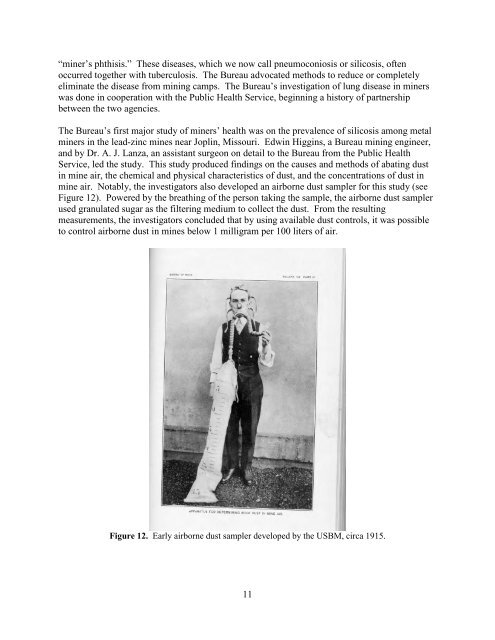One Hundred Years of Federal Mining Safety and Health Research
One Hundred Years of Federal Mining Safety and Health Research
One Hundred Years of Federal Mining Safety and Health Research
- No tags were found...
Create successful ePaper yourself
Turn your PDF publications into a flip-book with our unique Google optimized e-Paper software.
“miner’s phthisis.” These diseases, which we now call pneumoconiosis or silicosis, <strong>of</strong>ten<br />
occurred together with tuberculosis. The Bureau advocated methods to reduce or completely<br />
eliminate the disease from mining camps. The Bureau’s investigation <strong>of</strong> lung disease in miners<br />
was done in cooperation with the Public <strong>Health</strong> Service, beginning a history <strong>of</strong> partnership<br />
between the two agencies.<br />
The Bureau’s first major study <strong>of</strong> miners’ health was on the prevalence <strong>of</strong> silicosis among metal<br />
miners in the lead-zinc mines near Joplin, Missouri. Edwin Higgins, a Bureau mining engineer,<br />
<strong>and</strong> by Dr. A. J. Lanza, an assistant surgeon on detail to the Bureau from the Public <strong>Health</strong><br />
Service, led the study. This study produced findings on the causes <strong>and</strong> methods <strong>of</strong> abating dust<br />
in mine air, the chemical <strong>and</strong> physical characteristics <strong>of</strong> dust, <strong>and</strong> the concentrations <strong>of</strong> dust in<br />
mine air. Notably, the investigators also developed an airborne dust sampler for this study (see<br />
Figure 12). Powered by the breathing <strong>of</strong> the person taking the sample, the airborne dust sampler<br />
used granulated sugar as the filtering medium to collect the dust. From the resulting<br />
measurements, the investigators concluded that by using available dust controls, it was possible<br />
to control airborne dust in mines below 1 milligram per 100 liters <strong>of</strong> air.<br />
Figure 12. Early airborne dust sampler developed by the USBM, circa 1915.<br />
11
















